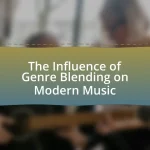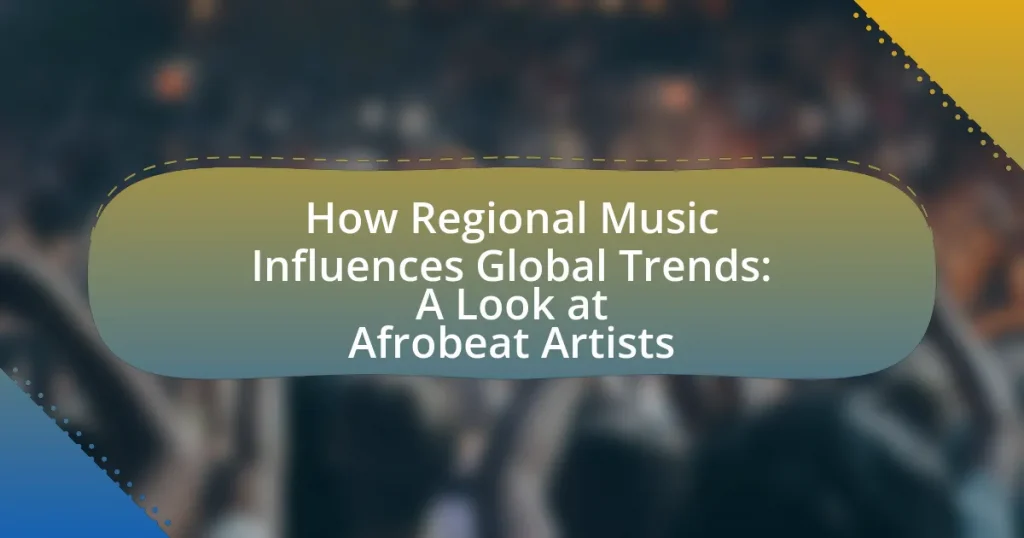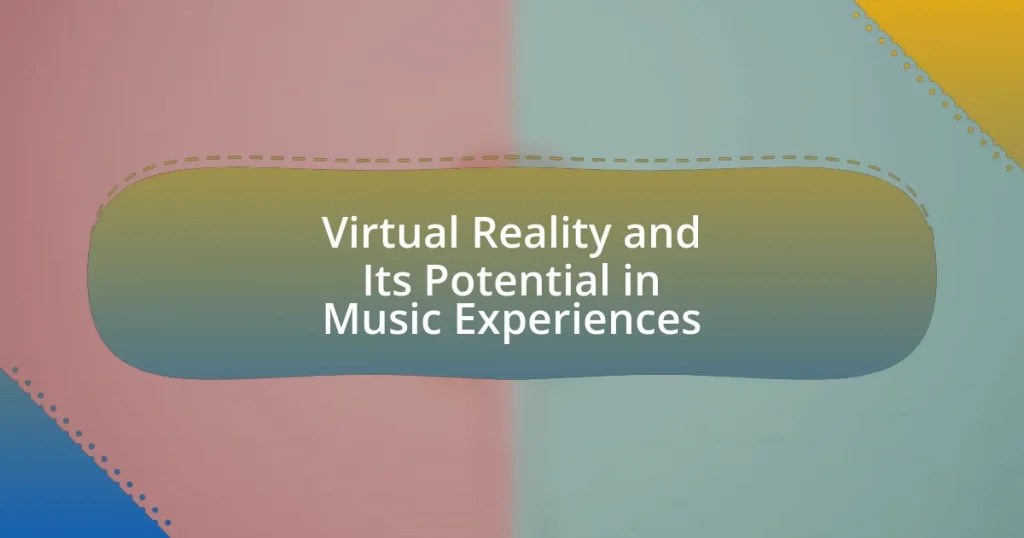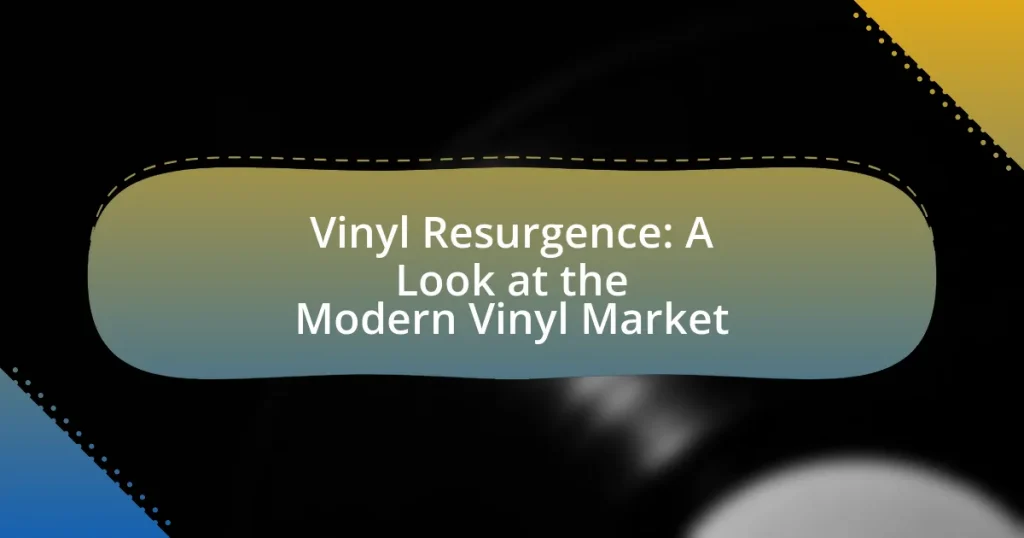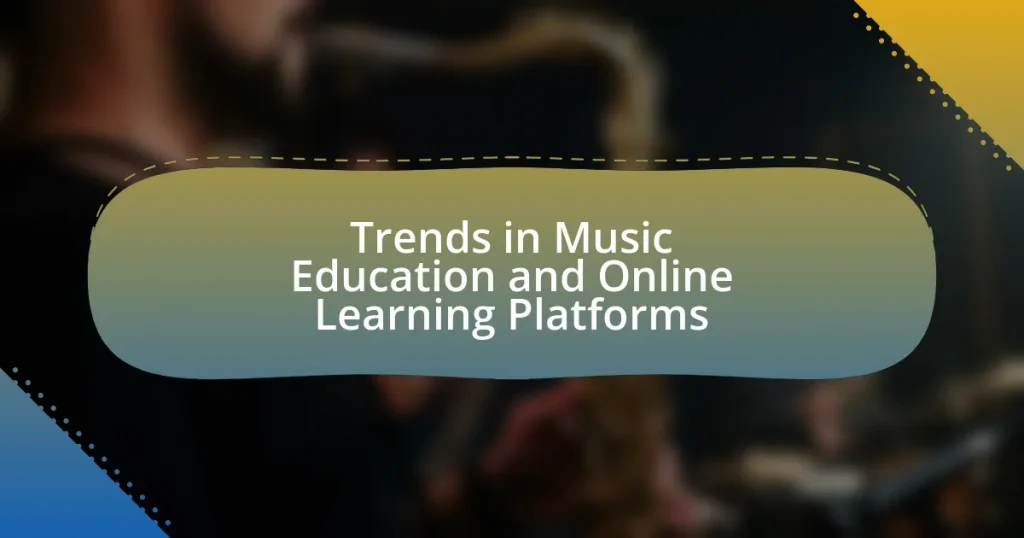The article examines how regional music, specifically Afrobeat, influences global trends by introducing unique sounds and cultural narratives that resonate with diverse audiences. It highlights the role of Afrobeat artists, such as Burna Boy and Wizkid, in shaping these trends through collaborations with international musicians and the incorporation of traditional African elements into contemporary genres. The evolution of Afrobeat, characterized by its fusion of traditional rhythms with jazz and modern production techniques, is discussed alongside its cultural significance and appeal to younger demographics. Additionally, the impact of digital platforms and social media on the global reach of Afrobeat is analyzed, along with emerging artists who are expected to shape the genre’s future.
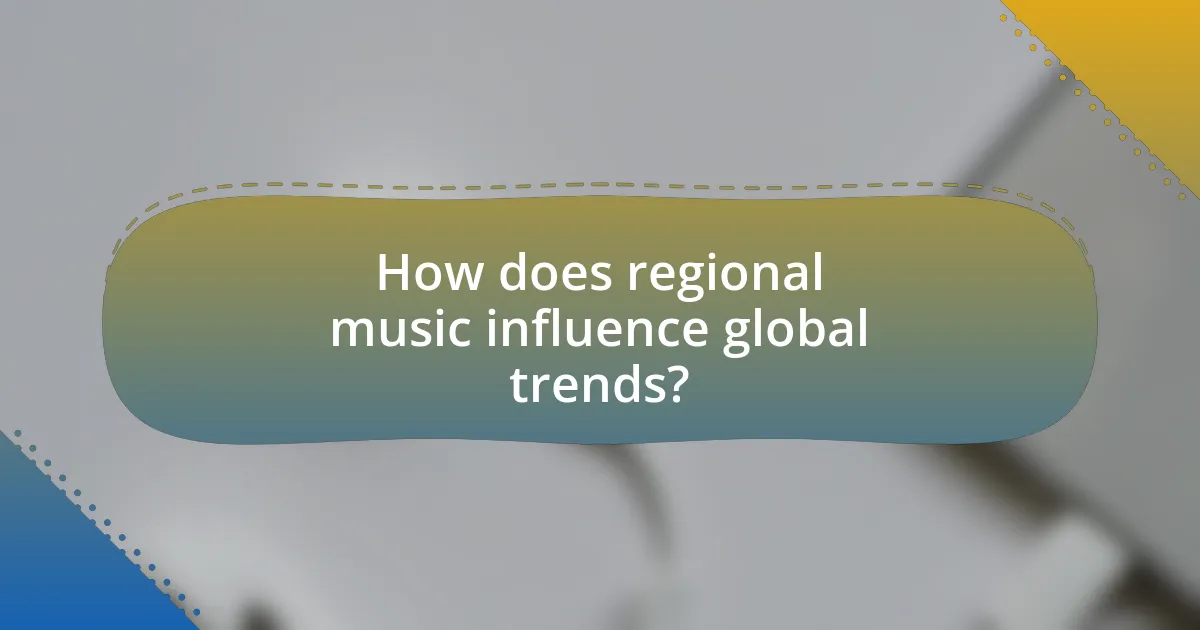
How does regional music influence global trends?
Regional music influences global trends by introducing unique sounds, rhythms, and cultural narratives that resonate with diverse audiences. For instance, Afrobeat, originating from Nigeria, has gained international popularity, impacting genres like hip-hop and pop music. Artists such as Burna Boy and Wizkid have collaborated with global stars, blending traditional African elements with contemporary styles, which has led to a broader acceptance and integration of African music in mainstream culture. This cross-pollination is evidenced by the Grammy Awards, where Afrobeat artists have received nominations and wins, highlighting the genre’s growing significance on the world stage.
What role do Afrobeat artists play in this influence?
Afrobeat artists play a crucial role in shaping global music trends by blending traditional African rhythms with contemporary genres, thereby creating a unique sound that resonates worldwide. This fusion not only attracts diverse audiences but also influences other music styles, as seen in collaborations with international artists and the incorporation of Afrobeat elements in pop, hip-hop, and electronic music. For instance, artists like Burna Boy and Wizkid have achieved global recognition, with Burna Boy’s album “African Giant” nominated for a Grammy, showcasing the genre’s impact on the international music scene.
How have Afrobeat rhythms and styles evolved over time?
Afrobeat rhythms and styles have evolved significantly since their inception in the late 1960s, primarily through the fusion of traditional African music with jazz, funk, and highlife. This genre, pioneered by Fela Kuti, initially featured complex polyrhythms and extended instrumental sections, which have since diversified to incorporate electronic elements and global musical influences. For instance, contemporary Afrobeat artists like Burna Boy and Wizkid blend traditional Afrobeat with hip-hop and dancehall, reflecting a shift towards more accessible and commercially viable sounds. This evolution is evidenced by the increasing presence of Afrobeat in international music charts and collaborations with global artists, showcasing its adaptability and growing influence on global music trends.
What cultural elements do Afrobeat artists incorporate into their music?
Afrobeat artists incorporate various cultural elements into their music, including traditional African rhythms, jazz influences, and social and political themes. Traditional African rhythms are foundational, often featuring complex polyrhythms that reflect the diverse musical heritage of the continent. Jazz influences are evident in the improvisational style and instrumentation, particularly the use of horns and syncopated beats. Additionally, Afrobeat music frequently addresses social and political issues, drawing from the historical context of Nigeria and the broader African experience, as exemplified by artists like Fela Kuti, who used his music as a platform for activism against government corruption and social injustice.
Why is the global appeal of Afrobeat significant?
The global appeal of Afrobeat is significant because it transcends cultural boundaries and fosters cross-cultural connections. This genre, which blends traditional African music with jazz, funk, and highlife, has gained international recognition, evidenced by artists like Burna Boy and Wizkid achieving chart-topping success in various countries. The genre’s rhythmic complexity and vibrant instrumentation resonate with diverse audiences, contributing to its widespread popularity. Additionally, Afrobeat’s themes of social justice and political commentary, as seen in the works of Fela Kuti, enhance its relevance and relatability on a global scale, making it a powerful vehicle for cultural exchange and social awareness.
What demographics are most drawn to Afrobeat music?
Young adults aged 18 to 34 are the demographics most drawn to Afrobeat music. This age group is particularly attracted to the genre due to its vibrant rhythms, danceable beats, and cultural significance, which resonate with their social experiences and lifestyle. Additionally, Afrobeat has gained popularity among diverse audiences globally, especially in urban areas, where multicultural influences thrive. According to a 2021 report by the International Federation of the Phonographic Industry, Afrobeat’s streaming numbers have surged, indicating a growing interest among younger listeners across various regions, including North America and Europe.
How does Afrobeat compare to other global music genres?
Afrobeat is distinct from other global music genres due to its unique fusion of traditional African rhythms, jazz, funk, and highlife, creating a complex and polyrhythmic sound. This genre, pioneered by Fela Kuti in the 1960s, emphasizes social and political themes in its lyrics, setting it apart from genres like pop or rock, which often focus on personal or romantic themes. Afrobeat’s instrumentation typically includes a large ensemble of musicians, featuring horns, guitars, and percussion, which contrasts with the more streamlined arrangements found in many Western genres. Additionally, Afrobeat has gained international recognition, influencing artists across various genres, thereby contributing to a global appreciation of African music and culture.
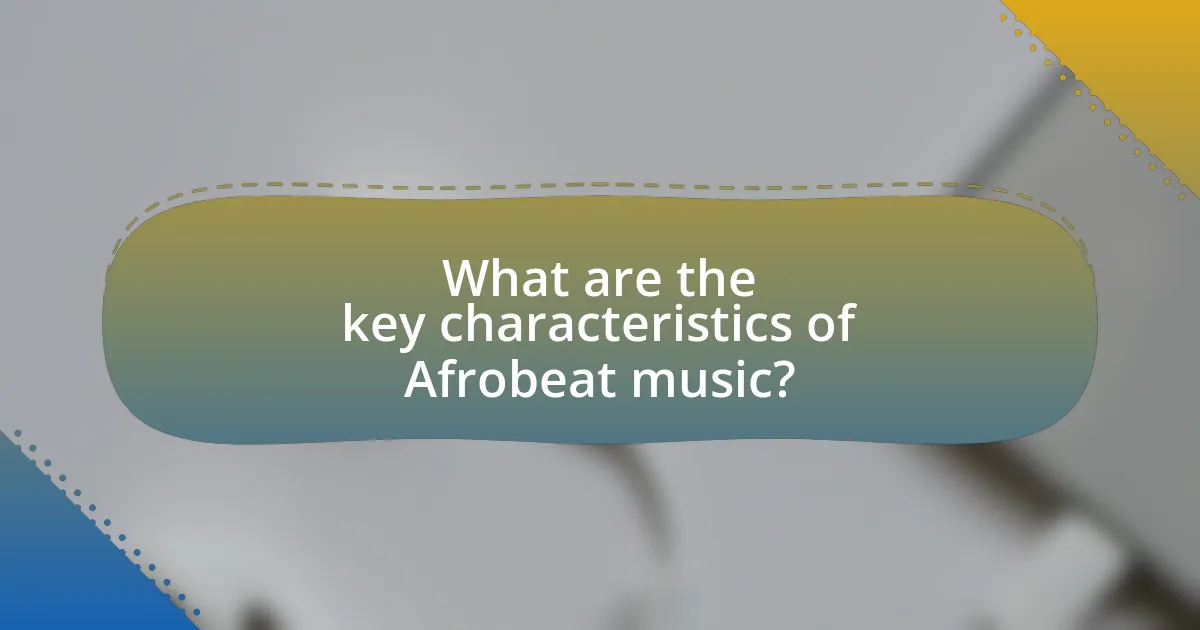
What are the key characteristics of Afrobeat music?
Afrobeat music is characterized by its fusion of traditional African rhythms, jazz, funk, and highlife, creating a complex and vibrant sound. This genre typically features intricate polyrhythms, extended instrumental sections, and socially conscious lyrics, often addressing political and cultural issues. Notably, Afrobeat was popularized by Nigerian musician Fela Kuti in the 1970s, who incorporated elements of Western music while maintaining African musical traditions. The genre’s emphasis on live instrumentation, particularly brass and percussion, further distinguishes it, making it a dynamic and engaging form of music that has influenced global music trends significantly.
How do instrumentation and production techniques define Afrobeat?
Instrumentation and production techniques define Afrobeat through the use of a diverse array of instruments and layered soundscapes that create its distinctive rhythmic and melodic structure. Afrobeat typically incorporates traditional African instruments like the talking drum, shekere, and kora, alongside Western instruments such as electric guitars, keyboards, and brass sections, which contribute to its rich, polyrhythmic texture. The production techniques often involve complex arrangements, with an emphasis on groove and syncopation, allowing for extended jams and improvisation, as seen in the works of Fela Kuti and Tony Allen. This blend of instrumentation and innovative production methods has not only shaped Afrobeat’s unique sound but also influenced global music trends, as artists worldwide adopt its rhythmic complexity and fusion of styles.
What traditional African instruments are commonly used in Afrobeat?
Traditional African instruments commonly used in Afrobeat include the talking drum, shekere, and djembe. The talking drum, known for its ability to mimic human speech, plays a crucial role in communication and rhythm within Afrobeat music. The shekere, a percussion instrument made from a gourd covered with a net of beads, adds texture and rhythm to the sound. The djembe, a hand drum originating from West Africa, contributes to the dynamic beats characteristic of Afrobeat. These instruments are integral to the genre, reflecting its roots in African musical traditions and enhancing its global appeal.
How do modern production techniques enhance Afrobeat’s sound?
Modern production techniques enhance Afrobeat’s sound by integrating advanced digital tools and software that allow for greater precision and creativity in music creation. These techniques, such as digital audio workstations (DAWs), enable artists to layer complex rhythms, manipulate sounds, and incorporate a wide range of influences from various genres, resulting in a richer and more dynamic sound. For instance, the use of sampling and electronic instrumentation has expanded the sonic palette of Afrobeat, allowing for innovative fusions with genres like hip-hop and electronic dance music. This evolution is evident in the works of contemporary Afrobeat artists who utilize these technologies to create tracks that resonate on global platforms, thereby influencing international music trends.
What lyrical themes are prevalent in Afrobeat songs?
Lyrical themes prevalent in Afrobeat songs include social and political commentary, love and relationships, and cultural identity. Afrobeat artists often address issues such as corruption, inequality, and social justice, reflecting the socio-political landscape of their home countries. For instance, Fela Kuti, a pioneer of Afrobeat, used his music to critique the Nigerian government and advocate for human rights, which has influenced many contemporary artists. Additionally, themes of love and personal relationships are common, showcasing the emotional depth and complexity of human experiences. Cultural identity is also a significant theme, as artists celebrate African heritage and traditions, fostering a sense of pride and connection among listeners.
How do Afrobeat artists address social and political issues in their lyrics?
Afrobeat artists address social and political issues in their lyrics by incorporating themes of corruption, inequality, and social justice. For instance, Fela Kuti, a pioneer of Afrobeat, used his music to critique the Nigerian government and highlight the struggles of the oppressed, famously addressing police brutality and political corruption in songs like “Zombie.” Contemporary artists, such as Burna Boy, continue this tradition by addressing issues like systemic racism and economic disparity, as seen in his song “African Giant,” which discusses the challenges faced by Africans globally. This lyrical focus not only raises awareness but also inspires activism, demonstrating the genre’s role in reflecting and influencing societal change.
What messages do Afrobeat songs convey about African culture?
Afrobeat songs convey messages of social justice, political awareness, and cultural pride within African culture. These songs often address issues such as corruption, inequality, and the struggles faced by marginalized communities, reflecting the socio-political landscape of various African nations. For instance, Fela Kuti, a pioneer of Afrobeat, used his music to criticize the Nigerian government and advocate for human rights, which highlights the genre’s role as a platform for activism. Additionally, Afrobeat celebrates African heritage through its incorporation of traditional rhythms, languages, and themes, fostering a sense of identity and unity among listeners. This cultural expression not only resonates within Africa but also influences global music trends, as artists worldwide draw inspiration from its rich sounds and messages.
How has the rise of digital platforms affected Afrobeat’s global reach?
The rise of digital platforms has significantly expanded Afrobeat’s global reach by providing artists with direct access to international audiences. Platforms like Spotify, Apple Music, and YouTube have enabled Afrobeat musicians to distribute their music worldwide without traditional barriers, leading to increased streaming numbers and global collaborations. For instance, Burna Boy’s album “African Giant” gained international acclaim and was nominated for a Grammy, showcasing how digital platforms can elevate regional genres to global prominence. Additionally, social media has facilitated viral trends, allowing Afrobeat songs to penetrate mainstream culture, as seen with the global success of tracks like “Jerusalema.”
What role do streaming services play in promoting Afrobeat artists?
Streaming services play a crucial role in promoting Afrobeat artists by providing a global platform for their music, enabling wider reach and accessibility. These platforms, such as Spotify and Apple Music, allow Afrobeat artists to distribute their music to international audiences, significantly increasing their visibility. For instance, Spotify reported that Afrobeat playlists have seen substantial growth, with millions of followers, which directly contributes to the genre’s popularity outside of Africa. Additionally, streaming services often feature Afrobeat artists in curated playlists and algorithm-driven recommendations, further enhancing their exposure and listener engagement. This accessibility and promotion through streaming services have led to notable collaborations and increased chart performance for Afrobeat artists on global music charts.
How has social media contributed to the popularity of Afrobeat?
Social media has significantly contributed to the popularity of Afrobeat by providing a platform for artists to share their music globally and engage with fans directly. Platforms like Instagram, Twitter, and TikTok allow Afrobeat artists to showcase their work, connect with audiences, and promote their songs through viral challenges and trends. For instance, the song “Jerusalema” by Master KG gained international fame largely due to its viral dance challenge on TikTok, illustrating how social media can propel regional music into the global spotlight. Additionally, social media facilitates collaborations between Afrobeat artists and international musicians, further expanding their reach and influence.
What collaborations have helped elevate Afrobeat on the global stage?
Collaborations with international artists have significantly elevated Afrobeat on the global stage. Notable partnerships include Burna Boy’s collaboration with American rapper JAY-Z on the track “Mo Money Mo Problems,” which showcased Afrobeat’s appeal to a wider audience. Additionally, Wizkid’s feature on Drake’s “One Dance” in 2016 propelled Afrobeat into mainstream music, leading to increased recognition and chart success. These collaborations have not only expanded the reach of Afrobeat but also influenced global music trends, as evidenced by the genre’s growing presence in international music festivals and charts.
Which international artists have collaborated with Afrobeat musicians?
International artists who have collaborated with Afrobeat musicians include Drake, Beyoncé, and Major Lazer. Drake featured Wizkid on the track “One Dance,” which topped charts globally, showcasing the fusion of Afrobeat with mainstream pop. Beyoncé collaborated with Nigerian artist Tiwa Savage on the song “Keys to the Kingdom,” part of the “Lion King: The Gift” album, further highlighting Afrobeat’s influence in global music. Major Lazer has worked with artists like Burna Boy and Mr Eazi, blending electronic music with Afrobeat elements, which has contributed to the genre’s worldwide appeal.
How do these collaborations impact the perception of Afrobeat music?
Collaborations with international artists significantly enhance the perception of Afrobeat music by broadening its audience and increasing its credibility. When Afrobeat artists partner with globally recognized musicians, they gain exposure to diverse fan bases, which elevates the genre’s status on the world stage. For instance, Burna Boy’s collaboration with Ed Sheeran on the track “Own It” introduced Afrobeat to millions of listeners who may not have been familiar with the genre, thereby fostering a greater appreciation for its unique sound and cultural roots. This cross-genre collaboration not only validates Afrobeat as a legitimate musical form but also encourages other artists to explore and incorporate Afrobeat elements into their work, further solidifying its influence in the global music landscape.
What are the future trends for Afrobeat in the global music scene?
Afrobeat is expected to continue its rise in the global music scene, driven by increased collaboration with mainstream artists and the integration of diverse musical styles. The genre’s fusion with pop, hip-hop, and electronic music is gaining traction, as seen in collaborations between Afrobeat artists like Burna Boy and international stars such as Ed Sheeran and Beyoncé. Additionally, the growing popularity of Afrobeat festivals and events worldwide, such as Afro Nation, highlights its expanding audience and cultural influence. The genre’s streaming numbers have surged, with platforms like Spotify reporting significant increases in Afrobeat playlists, indicating a broader acceptance and demand for the music globally.
How might Afrobeat evolve in response to changing musical tastes?
Afrobeat may evolve by incorporating diverse genres and modern production techniques to align with shifting musical preferences. As global audiences increasingly favor genres like hip-hop, electronic dance music, and pop, Afrobeat artists are likely to blend these styles into their music, creating hybrid sounds that resonate with wider demographics. For instance, artists such as Burna Boy and Wizkid have already begun integrating elements of trap and R&B into their Afrobeat tracks, demonstrating this adaptive approach. This evolution is supported by the growing popularity of Afrobeat on streaming platforms, where collaborations with international artists have led to increased exposure and acceptance of the genre, further influencing its development.
What emerging Afrobeat artists should we watch for in the future?
Emerging Afrobeat artists to watch for in the future include Ayra Starr, who gained significant attention with her debut EP “Ayra Starr” and hit single “Away,” showcasing her unique blend of Afrobeat and pop. Another notable artist is Omah Lay, recognized for his viral tracks like “Bad Influence” and his EP “Get Layd,” which highlights his innovative sound and lyrical depth. Additionally, Tems has made waves with her collaboration on Wizkid’s “Essence,” which has received international acclaim, indicating her rising influence in the genre. These artists are shaping the future of Afrobeat and are expected to play pivotal roles in its global expansion.
How can aspiring artists learn from successful Afrobeat musicians?
Aspiring artists can learn from successful Afrobeat musicians by studying their unique blend of traditional African rhythms with contemporary sounds, which has contributed to the genre’s global appeal. Successful Afrobeat musicians like Fela Kuti and Burna Boy have demonstrated the importance of cultural authenticity and innovation, allowing them to resonate with diverse audiences. For instance, Fela Kuti’s incorporation of social and political themes in his music not only showcased his artistry but also engaged listeners on critical issues, illustrating how music can serve as a platform for change. Additionally, Burna Boy’s strategic use of digital platforms for promotion has expanded his reach, highlighting the significance of leveraging technology in today’s music industry. By analyzing these approaches, aspiring artists can gain insights into creating impactful music that connects with a global audience while remaining true to their roots.








